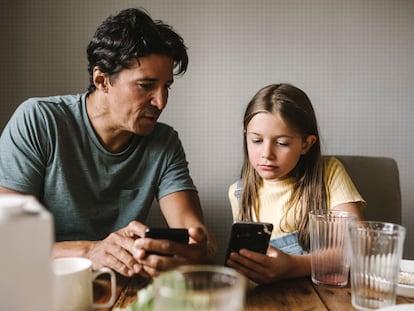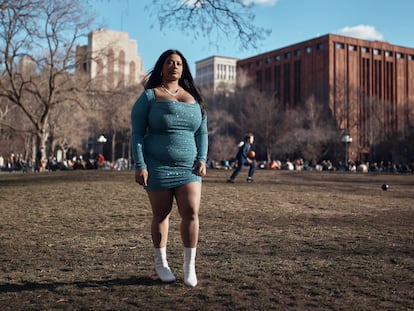Is it possible to regulate porn? Spain ponders how to keep adult content away from kids
Spain ranks 11th in porn consumption on the world’s largest platform, Pornhub. Experts point to violent pornography as problematic for emotional education and a factor in the increase of sexual violence among teenagers

Completely restricting minors’ access to pornography on the internet is like trying to bail out the ocean with a teaspoon. There are over 47 million Spaniards, and 94.9% have access to the internet, according to the latest We Are Social report from February. It’s everywhere: on cell phones, tablets, computers, videogames, televisions. And where there is an internet connection, there is porn. Spain ranks 11th in porn consumption on the world’s largest platform, Pornhub (it has over 120 million daily visits from around the world). But even if you’re not looking for it, porn is there: it appears in pop-up windows, search engine results for the most unlikely keywords, unsolicited advertisements and on social media. What’s the problem with this? There are several. Most of these clips show physically and verbally violent sex that is devoid of any empathy, consent, reciprocity or affection. Almost all of the violence is against women. And for most children and teenagers, pornography is the only source of sex education. Yet it includes slapping, women dragged by the hair, asphyxiation, simulations of rape and sometimes real rape. For several years, experts have pointed to this type of porn — so-called mainstream pornography, because not all porn is the same — as a factor that must be taken into account when examining the increase in sexual violence among minors.
In its latest annual report (with data from 2021), Spain’s Attorney General’s Office (FGE) noted: “The figures of cases initiated [for sexual crimes] are eloquent, and the delegates’ explanations are similar, albeit with different and interesting nuances. Without falling into moralism, they warn against the carelessness and banality with which sexual relations between adolescents are addressed. [...] Emphasis continues to be placed on highly sexualized behavior at a very early age. The early onset [of this behavior] is fundamentally linked to access to pornography on mobile devices [before they reach puberty].” Recent studies show that some children are as young as six or eight years old when they are first exposed to pornography.
In that report, the Attorney General’s Office referred to Granada’s Deputy Prosecutor, who “commented on the contradiction of dictating regulatory standards for this kind of content in the mass media, while, at the same time, there are no protocols to try to prevent minors from accessing pornographic web pages.”
Grenada’s Deputy Prosecutor was referring to the General Law on Audiovisual Communication, which was approved last summer and introduced measures for protecting users and minors from certain audiovisual content. The legislation responded to the 2018 European directive on this topic — which lacks precise instructions — by “establishing and operating age verification systems for users for any content that may harm the physical, mental or moral development of minors, which, in any case, prevent their access to the most harmful audiovisual content, such as gratuitous violence or pornography” and “providing parental control mechanisms or digital encryption systems.” But these norms only apply to television stations, or on-demand channels and platforms that are located in Spain, or elsewhere in European countries, and operate in Spanish territory.
What about the hundreds of thousands of porn sites that are registered all over the world? Upon opening any of them for the first time, a window appears with the warning “for adults only” and an “accept” button. All you need to do is click on it for millions of videos to appear before you. When you access the same site from the same device again, the warning does not even pop up, because the webpage’s memory (cookies) recognizes that you have already entered it.
Legislation and privacy rights
In recent years, the question of how to regulate pornography has arisen in Spain. In the last general elections, the Spanish Socialist Workers’ Party (PSOE) was the only party to include the issue in its platform: “We will prosecute sex trafficking and exploitation, especially of minors, and we will protect them from the creation of, dissemination of and exposure to pornography” and “promote redoubled protection of minors to prevent access to pornography.” The party confirms that it will retain that commitment for the next elections; it was also part of the current Government’s coalition agreement.
But the legislature is a few months away from the end of its term, and it hasn’t done anything in this area. The Law on Childhood and Adolescence generally introduced unsolicited access to pornography as a form of violence against minors, and it enacted some educational and awareness-raising measures on the subject. But no measures have been instituted to directly restrict access.
The idea is to verify the age of the people who access such content. Now, the Law on Personal Data Protection and Guarantee of Digital Rights establishes 14 years as the age of consent for processing personal data and includes “not demonstrating reasonable efforts to verify the validity of the consent given by a minor” as a very serious violating. But, according to the Spanish Data Protection Agency’s report Protecting Minors on the Internet, “so far, there is no evidence that the editors and publishers of adult content in Spain use any effective methods to check that users are of age.”
In the United States, the state of Louisiana has required identification since January 1 to be able to access any page whose content is at least one-third pornography. According to European legislation, such a measure would not be possible precisely because of user data protections. But “other countries [with laws similar to Spain’s in this regard] are trying or have already tried,” says Ana Valero, a professor of Constitutional Law at the University of Castilla-La Mancha and author of the book La libertad de la pornografía [The Right to Pornography].
One country to which she refers is the United Kingdom, which sought to pass “very problematic legislation” in terms of privacy rights: it was based on sending age-verification information to the sites, which in turn had to send it to the government. They desisted in 2019 and focused their efforts on sex education in schools and colleges. She also mentions Australia, “which wants to use facial recognition and may have the same privacy issues.” Finally, she cites France, which is working “on an age verification solution that respects the principle of double anonymity,” the French Minister of Digital Transition and Telecommunications, Jean-Noël Barrot, explained to the National Assembly in February. “Double anonymity” means that a telephone company, or any other platform through which this verification is provided, would not know what the data is used for, and the website on which the identification is used to gain access does not know the identity of the person entering it.
“We do not know which will be more effective, or if any of them will be…we will have to see how both legal rights are valued: on the one hand, data protection, but also the protection of youth and children [and] evaluate when it might be necessary to transfer data to protect minors,” adds Valero. “It should be possible to involve the platforms” in proactively collaborating in the implementation of verification systems, whatever they may be. “But the major industry is aware that teenagers are their new niche, and they are working to capture them on a massive scale,” Valero points out.
A €525,000 fine for personal data violations
So, what is the solution? In the current legislative context, it is not simple. Sources at the Data Protection Agency remind us that their powers are limited to protecting personal information. They say that they are “well aware that minors’ access to online adult content and that the addictive use of new technologies are habits that can entail serious risks for their development and mental health, as well as serious consequences for their family, educational and social environment.” They are working on solutions.
The agency also explains that the General Data Protection Regulation (GDPR) “gives regulatory authorities the ability to take corrective actions, of which levying an administrative fine is only one option; other measures include warnings, admonitions, and adopting measures to ensure that personal data processing complies with the law.”
Indeed, the AEPD initiated ex officio preliminary investigation proceedings against a company that owned several porn websites for alleged violations of data protection regulations, including the possible processing of the personal data of children under 14 years old that it obtained from browsing on its web pages. The case ended with “a financial penalty of €525,000 for violating several GDPR provisions and obligated the company to implement effective and adequate security measures to verify users’ ages to ensure that only persons of legal age can access web pages with adult content.”
But the AEPD does not always have the ability to act, as in cases when companies are located outside Spain. However, according to Lluís Ballester, a PhD in Sociology and an expert on the relationship between youth and pornography, the debate over how to protect minors from certain types of pornography is necessary: “We had the same debate about other products that were associated with freedom, like tobacco. Socially, we have come to accept strong restrictions on access to and consumption of [tobacco] because research showed its effects. Right now, the evidence on habitual pornography consumption is on a par with the [data] we had before tobacco restrictions.”
Education about emotions, relationships and sexuality
Ballester believes that there are measures that could be taken to achieve that, including “establishing by law that all internet-capable devices sold in Spain have parental controls activated by default; creating hotlines for complaints and advice for minors and families [which France has also done with the so-called Studer law and the 3018 phone number]; establishing an advisory council of experts on minors and risks in the National Commission of Markets and Competition’s audiovisual jurisdiction; and setting up the Audiovisual Council in all of Spain’s autonomous communities to work on this issue.”
Beyond concrete measures, both Valero and Ballester, along with other specialists, point to prevention as a clear objective. The latter says that “the best approach is education about emotions, affection, relationships, sexuality and digital literacy.” He adds that we need to activate protection mechanisms for people who are at risk and those who have already been harmed, including measures like “participation and research that allow us to better understand what is happening…with risks related to social media and video games [which pornography affects], for example.”
And he suggests making “well-scripted and well-produced films about sexuality that don’t show violence, submission, etc., which could respond to human sexual curiosity …outside the porn market.” For example, such content could be developed through the compulsory affective-sexual education for all ages included in the latest reform of the abortion law and the “only yes is yes” law. But Spain’s autonomous regions, which have jurisdiction over education, have not yet begun to develop them.
Sources at Spain’s Ministry of Equality say that “non-consensual and violent pornography requires a comprehensive response that is not based solely on the Penal Code. It is a question of making sex education cross-disciplinary and [involving it] in all areas of life.” They are referring to the two aforementioned regulations, which they were the driving force behind, along with other public policies like the 2022-2025 State Strategy for combatting male violence, “so that sex education, especially among minors, is not [done] through pornography.” They contend that “sex education for adolescent boys and girls is the most effective measure for preventing and discouraging the consumption of pornography.”
José Luis García, a psychologist and the co-director of the first university course on preventing the harmful effects of pornography at King Juan Carlos University (Universidad Rey Juan Carlos), says that based on his 45 years of experience, he is “more in favor of training boys and girls from very early on so that they learn to make decisions rationally and know what and where to look if they have concerns or need erotic stimuli.”
In the absence of education at home and at school, says Jorge Gutiérrez, the director of the non-profit organization Dale Una Vuelta [Give It a Look], the sexual, mental and emotional health of children and teenagers suffers. He argues that they notice “how [porn] is conducive to risky sexual behaviors [such as not using condoms] and a tendency to be more dissatisfied than satisfied when trying to emulate the practices they see, since those [practices] distort sex… [they also see that] the woman is always the one who experiences the most harm, even to the point of violence.” He adds that porn “can [also] be a gateway to addictive behaviors.”
“Most importantly, emotional [health]” is affected to the extent that “abusive consumption [of porn] can cause neglect of relationships [and] progressive isolation, and one ends up trapped in porn consumption.” Pornography can also be associated with “many boys’ maladaptive emotional management in an effort to avoid…loneliness, anxiety or anger, [then they] turn to [porn] consumption to escape from that, for instant gratification.” Gutiérrez likens minors surfing the web to “navigating a five-lane highway,” and says that efforts to regulate porn are akin to “creating a service road. Is it possible to prevent access to many places? No, but some barriers can be put in place… "
The billions of results that appear in less than a second by just typing the word “porn” in a search engine cannot be removed, but children and adolescents can at least be taught about what they will find. Let them know why such images have nothing to do with reality and what sex is really about. Unlike what appears “in mainstream porn,” Ana Valero says, sex involves “caring, reciprocity, consent [and] empathy.”
Sign up for our weekly newsletter to get more English-language news coverage from EL PAÍS USA Edition
Tu suscripción se está usando en otro dispositivo
¿Quieres añadir otro usuario a tu suscripción?
Si continúas leyendo en este dispositivo, no se podrá leer en el otro.
FlechaTu suscripción se está usando en otro dispositivo y solo puedes acceder a EL PAÍS desde un dispositivo a la vez.
Si quieres compartir tu cuenta, cambia tu suscripción a la modalidad Premium, así podrás añadir otro usuario. Cada uno accederá con su propia cuenta de email, lo que os permitirá personalizar vuestra experiencia en EL PAÍS.
¿Tienes una suscripción de empresa? Accede aquí para contratar más cuentas.
En el caso de no saber quién está usando tu cuenta, te recomendamos cambiar tu contraseña aquí.
Si decides continuar compartiendo tu cuenta, este mensaje se mostrará en tu dispositivo y en el de la otra persona que está usando tu cuenta de forma indefinida, afectando a tu experiencia de lectura. Puedes consultar aquí los términos y condiciones de la suscripción digital.
More information
Archived In
Últimas noticias
NASA discovers Titan doesn’t have an ocean, but a ‘slushy ice layer’ that increases possibility of life
Innocence lost in the forest of the child soldiers: ‘Each leader of the armed group had his girls’
‘Fallout’ or how the world’s largest company turned an anti-capitalist apocalyptic Western into a phenomenon
From inflation to defending migrants: Eileen Higgins and Zohran Mamdani inaugurate the new Democratic resistance against Trump
Most viewed
- ‘El Limones’ and the growing union disguise of Mexican organized crime
- Christian Louboutin: ‘Young people don’t want to be like their parents. And if their parents wear sneakers, they’re going to look for something else’
- The low-cost creative revolution: How technology is making art accessible to everyone
- ‘We are dying’: Cuba sinks into a health crisis amid medicine shortages and misdiagnosis
- Liset Menéndez de la Prida, neuroscientist: ‘It’s not normal to constantly seek pleasure; it’s important to be bored, to be calm’











































